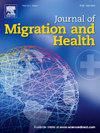Climate-induced migration and climate immobility in Ghana: A socio-ecological mixed method study
IF 2.9
Q1 PUBLIC, ENVIRONMENTAL & OCCUPATIONAL HEALTH
引用次数: 0
Abstract
Background
Several communities face the cyclical challenge of living with situations where climate change events and triggers push members to migrate at their own planned and prepared timelines or against their own prepared timelines often termed voluntary and involuntary climate-induced migration. There are others who express no desire to migrate despite the exposure to climate change stressors in addition to those who desire to migrate and or are unable to migrate and may feel trapped due to their exposure to climate change stressors (flood, extreme heat, windstorm and drought). The combined occurrence of these climate change outcomes (Climate change induced migration and Climate immobility) emerges as two polar end complicated socio-environmental challenge with varying socio-economic impacts on livelihoods. This study examines the drivers of climate-induced migration and climate immobility among rural and peri‑urban Ghanaian residents in the northern and upper-east regions of Ghana.
Method
The study was anchored on an embedded concurrent mixed method design, with 2125 persons surveyed and 21 interviews conducted across 12 communities in the Talensi and Savelugu district in Upper East and Northern region of Ghana. Multistage cluster sampling and purposive sampling were used to select participants for both quantitative and qualitative component of the study. The dependent variables were climate migration and climate immobility. The independent variables include socio demographic characteristics and participants experience with climate induced displacement. Using a multilevel regression analysis, the determinants of climate migration and climate immobility are analyzed with variables considered significant at p < 0.05. A comparative thematic approach guided the qualitative analysis.
Results
The experience of climate-induced migration was reported by 462(21.7%) individuals. Nearly half, 1060(49.9%) respondents were climate change immobile reflected in their show of no intentions of relocating from their present location notwithstanding climate change conditions. The age of residents with persons 36–45 years and above 55 years showed an increased likelihood of being climate immobile. Moreover, income levels were positively associated with climate immobility as individuals with low income (aOR= 1.607;95% CI= 1.247,2.071) had higher odds of being climate immobile. For climate-induced migration, individuals who self-rated their present health condition as poorer than a year ago had a greater likelihood of migrating (aOR=2.690;95%CI=1.744–4.148) compared to those with better health status. The qualitative narratives present the predictability of climate displacement experiences of an annual minimum of 3 to 14 times occurrences heralded by flooding from Bagre Dam spillage.
Conclusion
The central and local government authorities must strengthen the existing adaptive capacities of climate change-induced vulnerable populations.
加纳气候引起的移民和气候不流动:一项社会生态混合方法研究
一些社区面临着周期性的挑战,即气候变化事件和触发因素迫使成员按照自己计划和准备的时间表或违背自己准备的时间表(通常称为自愿和非自愿气候引起的移民)迁移。还有一些人尽管面临气候变化的压力,但仍表示没有迁移的意愿,此外还有一些人希望迁移或无法迁移,并可能因面临气候变化的压力(洪水、极端高温、风暴和干旱)而感到被困住。这些气候变化结果(气候变化引起的移民和气候不流动)的综合发生成为两极复杂的社会环境挑战,对生计产生不同的社会经济影响。本研究考察了加纳北部和上东部地区农村和城郊居民中气候引起的移民和气候不流动的驱动因素。该研究采用嵌入式并行混合方法设计,在加纳上东部和北部地区的Talensi和Savelugu地区的12个社区进行了2125人的调查和21次访谈。采用多阶段整群抽样和目的抽样来选择定量和定性研究的参与者。因变量为气候迁移和气候不动。自变量包括社会人口特征和参与者对气候导致的流离失所的经历。使用多水平回归分析,对气候迁移和气候不动的决定因素进行了分析,变量在p <; 0.05水平上被认为是显著的。比较专题方法指导了定性分析。结果共有462人(21.7%)报告了气候迁移经历。近一半(1060人)(49.9%)的受访者认为气候变化不会改变,这反映在他们表示尽管气候变化,但他们无意从目前的位置搬迁。年龄在36-45岁和55岁以上的居民表现出气候不迁移的可能性增加。此外,收入水平与气候不动正相关,低收入个体(aOR= 1.607;95% CI= 1.247,2.071)具有更高的气候不动几率。对于气候导致的移民,自认为目前健康状况比一年前差的个体与健康状况较好的个体相比,迁移的可能性更大(aOR=2.690;95%CI= 1.744-4.148)。定性叙述提出了气候迁移经历的可预测性,每年至少发生3至14次,预示着巴格雷大坝溢流引发的洪水。结论中央和地方政府必须加强气候变化导致的脆弱人群的现有适应能力。
本文章由计算机程序翻译,如有差异,请以英文原文为准。
求助全文
约1分钟内获得全文
求助全文
来源期刊

Journal of Migration and Health
Social Sciences-Sociology and Political Science
CiteScore
5.70
自引率
8.70%
发文量
65
审稿时长
153 days
 求助内容:
求助内容: 应助结果提醒方式:
应助结果提醒方式:


